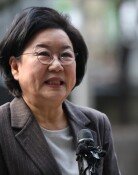[Op-Ed] Reopening of Myeongdong Art Theater
[Op-Ed] Reopening of Myeongdong Art Theater
Posted May. 13, 2009 08:10,
A couple of coffee shops began opening in Seoul`s downtown district of Myeongdong in 1951, an area which had fallen into ruin due to the Korean War. Writers and artists started flocking to the downtown area to discuss life and art at cafes and bars. They led the life described in the poem Wooden Horse and Lady by Park In-hwan. The poem goes, Taking a glass of wine / We talk about the life of Virginia Woolf / And the dress-wings of the lady who has gone on the back of a wooden horse. Poetry readings, music concerts and art exhibitions were held. Myeongdong turned into Korea`s center for culture and art and a gathering place filled with the pure in spirit and romanticism in the 1950s and 60s.
The National Theater opened in Myeongdong in 1957, ushering in the Myeongdong era. With television not yet introduced, the theater attracted huge audiences. Initially staging only plays, the theater later embraced genres such as dance and choruses. Its popularity made Myeongdong a more bustling place with lots of literary figures and artists. A bar named "Eunseong," which was run by the mother of Koreas famous entertainer Choi Bul-am, was a place where like-minded artists got together. The bar owner was generous to writers and artists and provided drinks on credit.
Prompted by North Koreas lead in the performing arts, South Korea hurriedly set up the National Theater shortly after liberation from Japanese colonial rule in 1945. Performing arts in the North flourished thanks to dramatic actors who defected to the North en masse shortly after liberation. The National Theater staged its first play Wonsulang in April 1950, but had to close after the Korean War broke out the same year. The theater reopened at a Myeongdong building owned by the Seoul city government under the condition that the theater serves as a public hall. As it moved into a new building in Seoul`s Jangchung district in 1973, Myeongdong`s fame as a cultural hub diminished.
The former National Theater in Myeongdong will reopen as Myeongdong Art Theater at the original building. The building has remained intact though it was sold to a private company in 1975. At the request of artists, the government has restored the theater by purchasing the building. Senior actors reportedly shed tears when revisiting the theater, which is scheduled to reopen June 5. They probably wish Myeongdong will regain its reputation as the country`s cultural center, missing the old days when they enjoyed art and life despite being poor. Hopefully, the new theater will lead the resurrection of art in the Myeongdong district.
Editorial Writer Hong Chan-sik (chansik@donga.com)



![화장실 갇혔을 때 생존법…“최후에는 변기뚜껑” [알쓸톡]](https://dimg.donga.com/c/138/175/90/1/wps/NEWS/IMAGE/2025/12/26/133042007.3.png)



